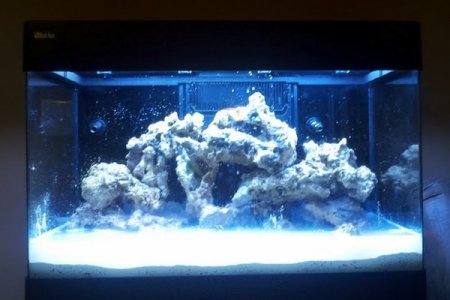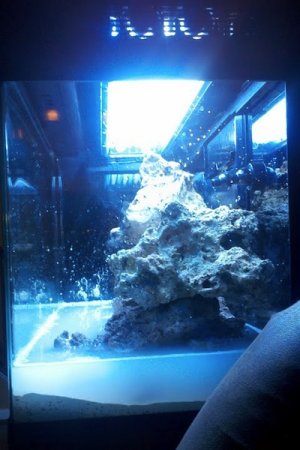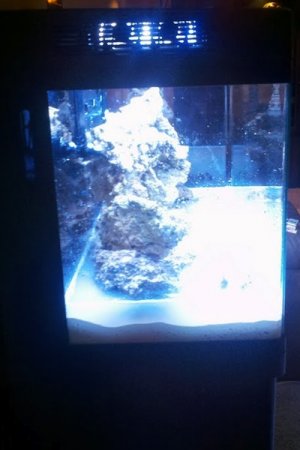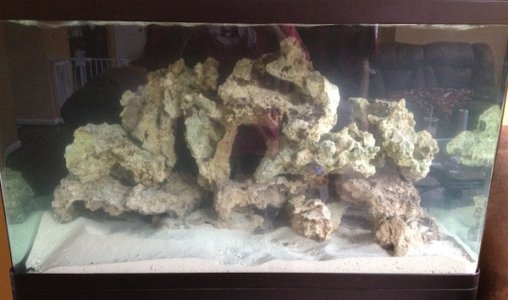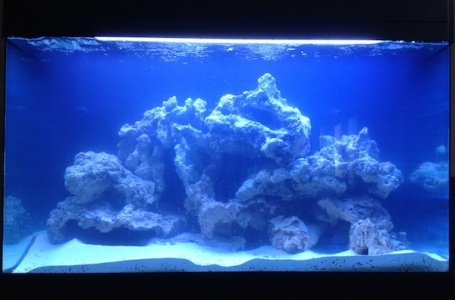Hi all!
I am new to the community and last night was the start of our (my wife Huly just joined as well) Reef Aquarium adventure!
A couple weeks ago, we were privileged to be able to get our hands on a Red Sea Max 250 (65 gal). We figured the all in one setup would be good for rookies to the saltwater game and allow us a little leniency in our inexperience. We have been talking to a million folks and reading articles, blogs, forums and books. The only downside to that of course is that everyone has their own way of doing things (frustrating for someone looking for straight answers).
I setup the stand and the main tank along with the hood. While the systems itself is very cool and sleek looking, their instructions could use a bit more details and diagrams for those of us that are rookies with this equipment and don't fully understand their relationships (a youtube vide of a tank setup would be even better). Frustrations arose (specifically around the installation of the skimmer), and I cursed red sea max several times, but in the end, I got it done.
My wife and I are from Leesburg, VA, and we found a jewel of a place in Catharpin, VA called Blue Ribbon Koi (apparently well known on here) who were extremely knowledgaeble and were great folks to talk to about my setup. Given that we were initially setting up the system and I wanted 40 lbs+ of live rock, we took a trip up to That Fish Place in Lancaster, PA (yeah about a 2.5 hour drive) where we were able to pick up about 40 lbs of live rock and about 30 lbs of dead rock (some really cool pieces) for about 300 bucks (they have a big summer discount going on).
I already had some sand (2x40lb bags of CaribSea Ocean Direct Live Sand + 5 lb bag) from the guy I got the aquarium from. We ran out to Marine Scene for a buttload of 5 gallon tanks of RO/DI saltwater and some RO/DI freshwater (for top offs and other necessities). I thoroughly hosed down the dead rock till it ran clear and stacked the dead rock at the base and the live rock on top (girl at that fish place said no need for rinsing the rock as the stuff that comes off helps with the cycling of the tank. I hope that by stacking the live on top, that it seeds the rock below it. In the process of the stacking I made sure to create lots of caves and swim throughs so that my fish have a big playground! I took the hose again and thoroughly rinsed my live sand for about 10 min per batch making sure that I was scooping through all the sand and hopefully getting rid of all the dust and any fine particles or whatever else should not be in there.
We put the sand in the tank making sure to spread it fairly evenly throughout the tank and all around the rocks. I then started process of filling the tank with the saltwater.... this thing takes a lot of water! The proceses of filling the tank of course swirled the water (though I was spilling the water on the rocks trying to avoid direct pouring on the sand). after all was said and done we had...... a nice milky tank! LOL... Where did our rocks go?
The tank cleared significantly after about 6 hours, so I kicked off the pump leading through the filtration section and the pump that leads through the heating section of the tank. I did not turn the skimmer on, becuase I figure there is no protein to process and I did not turn the heater on because the water was already around 80 degrees (still is after about 12-14 hours).
The tank has really cleared up and the pumps seem to be doing their jobs. One thing that I did not mention, is that while I did keep the carbon bag in the red sea max filtration system (after rinsing of course), I replaced the contents of the biological bag (some sort of chalky white cylindrical objects) with a bunch of little chunks of live rock with a larger piece sitting on top of that bag. This has been recommended by a few folks I have talked to. As of now, the tank has been running with the filtration pumps since about 4:00am this morning (was up due to a long night of work). The tank looks good and I performed my first set of tests.. I also took some water in to a LFS to confirm my scores.
Here is what I got from my Coralife Deep Six Hydrometer:
Specific Gravity/Salinity PPT: 1.025 to 1.026/34
Here is what I got from my API Saltwater Master Test Kit:
Ammonia: 0 to 0.25
Ph: 7.9
nitrite: 2.0
nitrate: 20
Here is what my LFS got from using API 5 in 1 Aquarium Test Strips:
Ph: 7 (way off from what I got)
nitrite (NO2): 0
nitrate (NO3): 20
General Hardness (GH): 60
Carbonate Hardness (KH): 80
I am going to compile a list of questions and concerns I have in my next post, but for right now, here are some pics of the tank:
I am new to the community and last night was the start of our (my wife Huly just joined as well) Reef Aquarium adventure!
A couple weeks ago, we were privileged to be able to get our hands on a Red Sea Max 250 (65 gal). We figured the all in one setup would be good for rookies to the saltwater game and allow us a little leniency in our inexperience. We have been talking to a million folks and reading articles, blogs, forums and books. The only downside to that of course is that everyone has their own way of doing things (frustrating for someone looking for straight answers).
I setup the stand and the main tank along with the hood. While the systems itself is very cool and sleek looking, their instructions could use a bit more details and diagrams for those of us that are rookies with this equipment and don't fully understand their relationships (a youtube vide of a tank setup would be even better). Frustrations arose (specifically around the installation of the skimmer), and I cursed red sea max several times, but in the end, I got it done.
My wife and I are from Leesburg, VA, and we found a jewel of a place in Catharpin, VA called Blue Ribbon Koi (apparently well known on here) who were extremely knowledgaeble and were great folks to talk to about my setup. Given that we were initially setting up the system and I wanted 40 lbs+ of live rock, we took a trip up to That Fish Place in Lancaster, PA (yeah about a 2.5 hour drive) where we were able to pick up about 40 lbs of live rock and about 30 lbs of dead rock (some really cool pieces) for about 300 bucks (they have a big summer discount going on).
I already had some sand (2x40lb bags of CaribSea Ocean Direct Live Sand + 5 lb bag) from the guy I got the aquarium from. We ran out to Marine Scene for a buttload of 5 gallon tanks of RO/DI saltwater and some RO/DI freshwater (for top offs and other necessities). I thoroughly hosed down the dead rock till it ran clear and stacked the dead rock at the base and the live rock on top (girl at that fish place said no need for rinsing the rock as the stuff that comes off helps with the cycling of the tank. I hope that by stacking the live on top, that it seeds the rock below it. In the process of the stacking I made sure to create lots of caves and swim throughs so that my fish have a big playground! I took the hose again and thoroughly rinsed my live sand for about 10 min per batch making sure that I was scooping through all the sand and hopefully getting rid of all the dust and any fine particles or whatever else should not be in there.
We put the sand in the tank making sure to spread it fairly evenly throughout the tank and all around the rocks. I then started process of filling the tank with the saltwater.... this thing takes a lot of water! The proceses of filling the tank of course swirled the water (though I was spilling the water on the rocks trying to avoid direct pouring on the sand). after all was said and done we had...... a nice milky tank! LOL... Where did our rocks go?
The tank cleared significantly after about 6 hours, so I kicked off the pump leading through the filtration section and the pump that leads through the heating section of the tank. I did not turn the skimmer on, becuase I figure there is no protein to process and I did not turn the heater on because the water was already around 80 degrees (still is after about 12-14 hours).
The tank has really cleared up and the pumps seem to be doing their jobs. One thing that I did not mention, is that while I did keep the carbon bag in the red sea max filtration system (after rinsing of course), I replaced the contents of the biological bag (some sort of chalky white cylindrical objects) with a bunch of little chunks of live rock with a larger piece sitting on top of that bag. This has been recommended by a few folks I have talked to. As of now, the tank has been running with the filtration pumps since about 4:00am this morning (was up due to a long night of work). The tank looks good and I performed my first set of tests.. I also took some water in to a LFS to confirm my scores.
Here is what I got from my Coralife Deep Six Hydrometer:
Specific Gravity/Salinity PPT: 1.025 to 1.026/34
Here is what I got from my API Saltwater Master Test Kit:
Ammonia: 0 to 0.25
Ph: 7.9
nitrite: 2.0
nitrate: 20
Here is what my LFS got from using API 5 in 1 Aquarium Test Strips:
Ph: 7 (way off from what I got)
nitrite (NO2): 0
nitrate (NO3): 20
General Hardness (GH): 60
Carbonate Hardness (KH): 80
I am going to compile a list of questions and concerns I have in my next post, but for right now, here are some pics of the tank:

